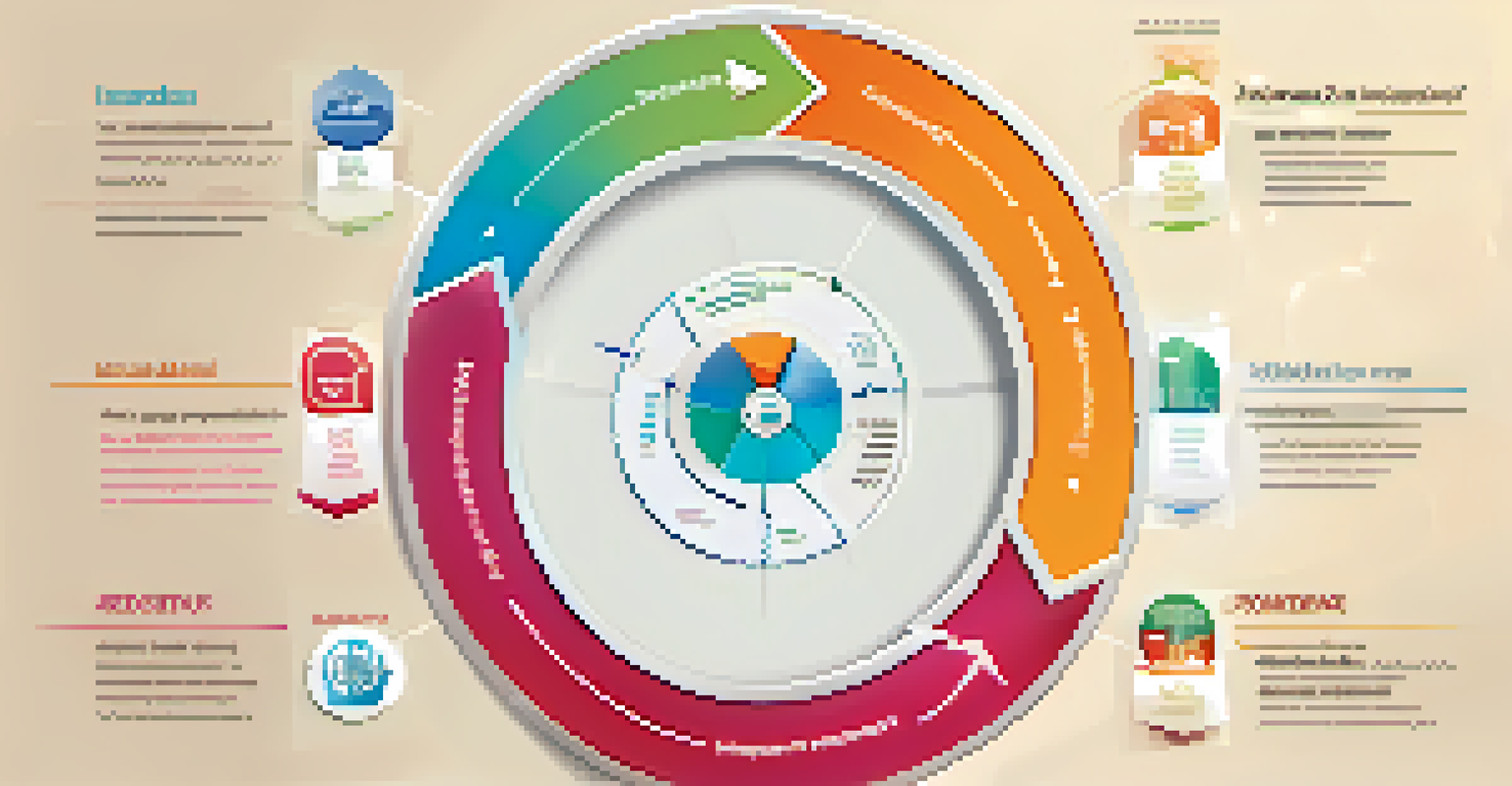The Importance of Continuous Improvement in Business Processes

Understanding Continuous Improvement in Business
Continuous improvement, often referred to as 'kaizen', is a philosophy that emphasizes ongoing enhancement in business processes. It’s not just a one-time fix but a regular practice that involves everyone in the organization, from top management to entry-level employees. This mindset fosters a culture of innovation and efficiency, encouraging teams to identify small, incremental changes that collectively lead to significant improvements.
Continuous improvement is better than delayed perfection.
For example, a manufacturing company might implement daily check-ins to discuss workflow efficiency. These brief meetings can lead to immediate feedback and quick adjustments, ultimately reducing waste and increasing productivity. The beauty of continuous improvement is that it creates a proactive environment where employees feel empowered to suggest changes, knowing their input is valued.
Moreover, the process is not limited to operational tasks; it can be applied to customer service, marketing strategies, and even employee training. By embracing continuous improvement, businesses can adapt to market changes and evolving consumer needs more effectively, ensuring long-term sustainability and growth.
Benefits of Continuous Improvement for Businesses
The advantages of continuous improvement are numerous and impactful. Firstly, it enhances operational efficiency by streamlining processes and eliminating redundancies, which can significantly reduce costs. For instance, a retail business may find that optimizing their inventory management can lead to fewer stockouts and overstocks, ultimately improving profitability.

Secondly, continuous improvement fosters a culture of accountability and engagement among employees. When team members are encouraged to share their insights, they feel a greater sense of ownership over their work. This empowerment not only boosts morale but also leads to higher productivity, as employees are more likely to go the extra mile when they see their contributions making a difference.
Embrace Continuous Improvement
Adopting a continuous improvement mindset fosters innovation, efficiency, and empowerment across all levels of an organization.
Lastly, businesses that prioritize continuous improvement tend to adapt more swiftly to changes in the market. In a world where consumer preferences and technologies evolve rapidly, being flexible and responsive is crucial for staying competitive. Companies that embrace this approach can pivot quickly, whether it’s refining a product based on customer feedback or adjusting marketing strategies to align with new trends.
Implementing Continuous Improvement Strategies
Implementing continuous improvement strategies begins with a clear understanding of current processes. This often involves mapping out workflows to identify areas that require enhancement. Techniques like process mapping or value stream mapping can help visualize the flow of operations, making it easier to pinpoint bottlenecks or inefficiencies.
Excellence is not a skill. It is an attitude.
In addition, organizations should establish key performance indicators (KPIs) to measure progress. These metrics enable teams to track improvements over time and assess the effectiveness of the changes made. For instance, a company might track customer satisfaction scores before and after implementing a new service protocol to determine its impact.
Lastly, fostering a culture of feedback is essential. Regularly soliciting input from employees and customers helps businesses stay attuned to the effectiveness of their strategies. Whether through surveys, suggestion boxes, or town hall meetings, creating an open dialogue encourages continuous refinement and shows that the organization values stakeholder opinions.
The Role of Leadership in Continuous Improvement
Leadership plays a pivotal role in driving continuous improvement within an organization. Leaders must set the tone by actively promoting a culture of innovation and encouraging their teams to embrace change. This can be achieved through regular communication about the importance of improvement initiatives and by leading by example—demonstrating a willingness to adapt and evolve.
Moreover, providing training and resources is crucial for empowering employees to engage in continuous improvement. Leaders should invest in workshops or courses that equip staff with the necessary tools and methodologies, such as Lean or Six Sigma, which are popular frameworks for driving efficiency. This investment not only enhances skills but also reinforces the organization's commitment to improvement.
Leadership Drives Change
Effective leadership is crucial for promoting a culture of continuous improvement by providing support, resources, and recognition.
Lastly, recognizing and rewarding efforts can significantly boost morale and motivation. Celebrating both small and large wins related to improvement initiatives helps reinforce positive behaviors and encourages others to participate. Acknowledging achievements, whether through formal awards or simple shout-outs, fosters a supportive environment where continuous improvement thrives.
Challenges in Continuous Improvement and How to Overcome Them
While the benefits of continuous improvement are clear, organizations often face several challenges during implementation. One common hurdle is resistance to change, particularly from employees who may feel threatened by new processes or technologies. To mitigate this, it’s essential to communicate the reasons behind changes and involve staff in the decision-making process.
Another challenge is maintaining momentum after initial improvements have been made. Organizations sometimes fall into the trap of complacency, believing that once changes are implemented, no further action is needed. To combat this, businesses should schedule regular reviews to assess progress and identify new areas for improvement, ensuring that the cycle of enhancement continues.
Lastly, measuring the impact of improvements can be complex, especially if the results are not immediately visible. Organizations should establish clear metrics and timelines for evaluating success, allowing for ongoing adjustments. By setting realistic expectations and remaining patient, businesses can fully realize the benefits of their continuous improvement efforts.
Real-World Examples of Continuous Improvement Success
Many successful companies have embraced continuous improvement as a core aspect of their operations. For instance, Toyota is renowned for its implementation of the Toyota Production System, which focuses on reducing waste and improving quality through continuous refinement. This approach has not only transformed their manufacturing processes but has also set a benchmark for other industries.
Another example is Amazon, which continually innovates its logistics and customer service processes. By analyzing customer data and feedback, they consistently refine their delivery systems and user interfaces, ensuring an exceptional shopping experience. This commitment to continuous improvement is a key factor in their sustained growth and customer loyalty.
Adapt to Market Changes
Continuous improvement enables businesses to swiftly adjust to shifting consumer preferences and technological advancements.
Even smaller businesses can reap the rewards of this philosophy. A local café might implement a feedback system to understand customer preferences better, leading to menu changes that boost sales. These real-world examples illustrate that regardless of size, organizations that prioritize continuous improvement can achieve remarkable results and stay ahead of the competition.
The Future of Continuous Improvement in Business
As we look to the future, continuous improvement will likely become even more integral to business success. With the rapid advancement of technology, companies must continuously adapt to stay relevant. Automation, artificial intelligence, and data analytics are tools that can greatly enhance the capability to identify areas needing improvement and streamline processes.
Moreover, the growing emphasis on sustainability and corporate responsibility means that businesses will need to continually refine their practices to meet ethical standards and consumer expectations. Continuous improvement can help organizations innovate in sustainable practices, reducing their environmental footprint while enhancing profitability.

Finally, as remote work becomes more commonplace, the need for effective communication and collaboration tools will rise. Companies will need to continuously improve their digital workflows and team interactions to maintain productivity and employee engagement. By embracing this mindset, businesses can not only navigate the challenges ahead but also seize new opportunities for growth.